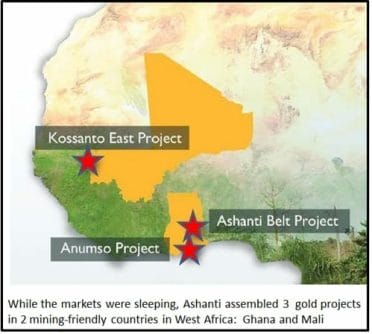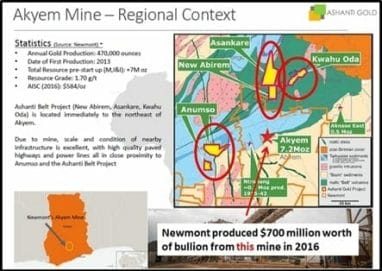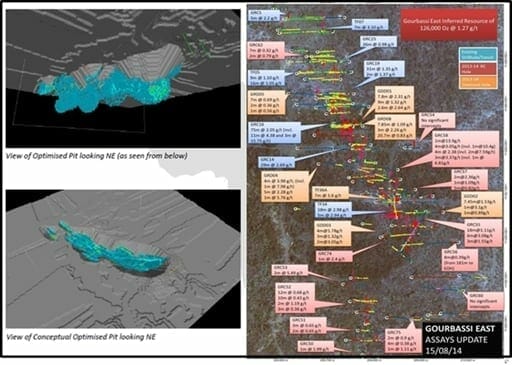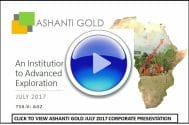The CEO of Ashanti Gold (AGZ.V) Tim McCutcheon is a former investment banker with a track record of finding inefficiencies in financial systems – and exploiting them for profit.
In 2012 there was a glaring inefficiency in the junior resource market place. The funding available to junior mining companies had completely dried up. Starved of nutrients, small explorers with good assets were dropping like flies.
 “The juniors involved in proving up the next round of projects died off,” recalled McCutcheon in an exclusive Equity Guru interview with Chris Parry, “because they couldn’t get funding. By 2012, most were gone.”
“The juniors involved in proving up the next round of projects died off,” recalled McCutcheon in an exclusive Equity Guru interview with Chris Parry, “because they couldn’t get funding. By 2012, most were gone.”
From a “top down” point of view, it was clear to McCutcheon that when the majors went looking for resource replacement in the near future, there would be very little developed product to purchase.
“It was a horrible time,” confirmed McCutcheon, “But it was clear that Western Africa has good geology and a lot of gold and all the senior mining companies are active in Africa.”
In fact, Western Africa has overtaken Southern Africa as the continent’s gold-mining epi-center. New gold projects are coming on stream in Burkina Faso, Ghana, Mali and Sierra Leone.
McCutcheon didn’t walk into Africa blind. He is the ex-CEO of Abzu Gold based in Ghana. He assembled an African-centric team. Ashanti’s Head Geologist, Dr. Paul Klipfel developed gold properties in the Ashanti belt area.
“We asked ourselves a basic question: ‘what do we know that others don’t know?’”, recalled McCutcheon. “We put a team together that had a competitive advantage. Because we had been Kinross’s JV exploration partner in Ghana, we had a huge data base from that experience. We identified an opportunity to cherry pick the best assets out of the Kinross portfolio”.
McCutcheon was able to acquire these assets on an ‘earn in’ basis – with very little initial outlay of capital.
McCutcheon is one of the largest investors in Ashanti.
“As an investor, I like to see teams of people dedicated to getting things done – as opposed to shuffling paper around,” stated McCutcheon. “Ashanti Gold is not a lifestyle company. When you see a company headquartered in Miami Beach – you know it’s a project attached to some guy’s lifestyle. We are not that.”
For comparables in Western Africa, the minimum valuation is $30 to $150 million. If you converge Ashanti with the lowest benchmark peer it would double the current market cap of $13 million.
Ashanti’s Anumso Gold project in Ghana is close to Newmont’s (NEM.NYSE) Akyem Mine which began production in 2013. For the last five years, the average annual gold production from Akyem is 400,000 ounces with an all-in sustaining cost of about $800 per ounce.
 Ashanti’s 29 sq km mining lease covers 5 km of strike length in the Ashanti Gold Belt. Ashanti has 75% earn-in option with Goldplat PLC.
Ashanti’s 29 sq km mining lease covers 5 km of strike length in the Ashanti Gold Belt. Ashanti has 75% earn-in option with Goldplat PLC.
In 2012, Goldplat announced a mineral resource estimate for a 2 km long portion of the “eastern conglomerate” of 6.2 million tonnes at an average grade of 1.25 grams per tonne, giving 250,000 ounces of gold at a 0.5 g/t cut-off. However, this resource estimate is not considered 43-101 compliant so Ashanti drilled it this spring.
“The reason I left investment banking is that I got tired of watching other people do things and commenting on it,” stated McCutcheon, “I wanted to be the doer. Management are collectively the 2nd largest shareholders. We are motivated by equity capital appreciation. When you buy stock in Ashanti gold stock you are on the same path as the management team”.
The phase 1 drill program on the Anumso project is now complete and the metallurgical work has begun at a Canadian lab. The work will establish gold recovery rates and lead to the best recovery methods.
Ashanti has also begun a soil sampling program, testing for new mineralized zones along the two main horizons on the Anumso license area. Later this year, Ashanti is planning more trenching and drilling.
The Ashanti Gold Belt is one of the most prolific gold bearing belts in the world, hosting Tarkwa (Goldfields), Obuasi (Anglogold/Ashanti) and Akyem (Newmont). The eastern edge of the Ashanti belt remains largely unexplored.
In Mali, a 53-hole, 6,000 meter RC drill program for the Kossanto East project has been completed.
Kossanto East is a 66 km2 concession sitting in a major geological structure for gold mineralization. Since 1998, about 40 million ounces of gold has been discovered in this area resulting in the construction of dozens of mines.
Ashanti is trying to expand areas of known mineralization and test the strike and dip within the limits of the historic resource. Samples have been sent to a laboratory in Bamako, Mali. The results are expected to be released in August 2017.
At Equity Guru, we are not going to tell you to invest in gold.
But numerous data points indicate the stock market is in a bubble and it’s about to pop.
For instance, the trailing 12-month Price/Earnings ratio for the market is 22 – 30% higher than the 10-year average of 16. It’s very close to the point where it was when the market last imploded.
Historically, the biggest gold investment returns have come from junior explorers or miners, building resources in mining-friendly jurisdictions with low labour costs.
“If someone says ‘I’m not comfortable in Africa”, that’s fine but you have to understand that you’ll be paying three to five times more elsewhere for the same type of asset,” stated McCutcheon. “If you’re investing in the junior mining space, you’re already taking on massive leverage conceptually because that’s the nature of the business.”
McCutcheon is right. Gold is risky. Exploration is risky. Africa is risky.
That’s why you can buy Ashanti Gold today for 39 cents.
When the stock market bubble pops, whoever has leverage to the price of gold is going to be wealthy. If someone asks how you did it, you can tell them: I took a risk – I got a reward.
We urge you to take a look at Ashanti’s July 2017 Corporate Presentation and decide for yourself.
FULL DISCLOSURE: Ashanti Gold is an Equity Guru marketing client. Our principal, Chris Parry owns a lot of stock.




